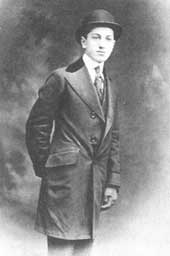George Gershwin |
|||||||
26 September, 1898 - 11 July, 1937
George Gershwin was born in Brooklyn, New York, September 26, 1898. He began his musical training at thirteen. At fifteen he left high school to work as a pianist and song-plugger for musical publishers. He was soon writing songs. "Swanee", introduced by Al Jolson, brought Gershwin his first real fame. But it was George and his older brother, Ira, who became the dominant Broadway songwriters to emerge during the 20s, creating a ceaseless flow of brisk, infectious rhythms and affectingly poignant ballads. Working together they fashioned the words to fit melodies with a "glove-like" fidelity. This extraordinary collaboration led to a succession of 22 musical comedies, among them Lady Be Good (1924), Oh, Kay! (1926), Funny Face (1927), Strike Up the Band (1927 & 1930), Girl Crazy (1930) and Of Thee I Sing (1931) - the first musical comedy to win a Pulitzer Prize. Over the years, Gershwin songs have also been used in numerous films and in the award-winning stage musicals, My One and Only (1983) and Crazy For You (1992). Crazy For You is loosely based on Girl Crazy, with a new libretto by Ken Ludwig and has an impressive roster of George and Ira songs including two previously unpublished songs. From his early career, Gershwin had ambitions to compose serious music. Asked by Paul Whiteman to write an original work for a special modern concert to be presented at Aeolian Hall in New York on February 12, 1924. Gershwin, who was hard at work on a musical comedy, barely finished his composition in time. From the first low chuckle of the solo clarinet and its spine-tingling run up the scale Rhapsody In Blue caught the public's fancy and opened a new era in American music.
In 1925, the eminent conductor, Walter Damrosch commissioned Gershwin to compose a piano concerto for the New York Symphony Society. Many feel that this Concerto in F is Gershwin's finest orchestral work. Others opt for An American in Paris (1928) or his Second Rhapsody For Piano and Orchestra which he introduced, with himself as the soloist, with the Boston Symphony Orchestra under Koussevitzsky in 1932. Gershwin, fascinated by the DuBose Heyward novel Porgy, recognised it as a perfect vehicle for opera using jazz and blues rhythms and idioms. What he called a "folk opera", Porgy and Bess
(co-written with DuBose and Dorothy Heyward and Ira Gershwin) was the Gershwin brothers' most ambitious undertaking, tightly integrating unforgettable songs with Drama. Porgy and Bess was first performed in Boston, September 30, 1935 and opened on Broadway October 10. In addition to its 1942 and 1953 revivals and subsequent world tours, it was made into a major motion picture in 1959. In 1937, George Gershwin was at the height of his career. His symphonic works and three Preludes For Piano were becoming part of the standard repertory for concerts and recitals, and his lighter songs had brought him ever increasing fame and fortune. It was in Hollywood, while he was working on the score of The Goldwyn Follies that George Gershwin collapsed and, on July 11, 1937, died of a brain tumour. He was not quite 39 years old. Today Gershwin's works are sung and played with ever greater frequency than they were in his brief lifetime. The songs and concert pieces are proving to be an enduring legacy as a glance at the pages of any record catalogue will quickly show. Taken from a publicity pack issued by Warner-Chappell Music to celebrate the centenary of George Gershwin's birth.
|
|||||||


